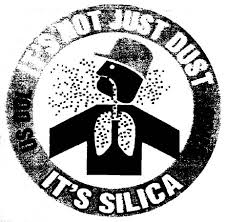Lung Disease: Silicosis
 The respiratory disease silicosis results from inhaling (breathing in) silica dust. It general occurs in people who have occupational exposure to the dust. It is not a commonly known disease but it is important to learn about it, especially as the workforce ages.
The respiratory disease silicosis results from inhaling (breathing in) silica dust. It general occurs in people who have occupational exposure to the dust. It is not a commonly known disease but it is important to learn about it, especially as the workforce ages.
A common crystal, silica appears throughout the natural world. For example, it can be found in the majority of rock beds. The silica dust forms as a result of mining, tunneling, and quarrying operations. Workers who come into contact with certain ores can also be exposed to silica dust. Another way to be exposed to silica is through the use of sand blasters and glass-making equipment. Silica is a major component of sand, which is used in these processes.
There are three types of this respiratory disease.
The first is called simple chronic silicosis. It comes from long-term (more than twenty years worth) of exposure to low levels of silica dust. This exposure causes the lungs and lymph nodes in the chest to swell up and become enlarged. This can result in difficulty breathing. It is the most commonly diagnosis form of the disease.
Another type is called accelerated silicosis. This occurs when an individual is exposed to higher levels of silica dust over a five to ten year period. The characteristic lung and lymph node swelling occur sooner than in the chronic form.
The final type is known as acute silicosis. This results from a short exposure to a very high level of silica dust. The lungs become extremely swollen and inflamed. They can even fill up with fluid, similar to pneumonia, resulting in low blood oxygen and very severe difficulty breathing.
Progressive massive fibrosis can result from either the simple or the accelerated forms, but is more likely to occur alongside the accelerated form. This causes scarring of the lungs and actually destroys the normal structure of the lungs.
Anyone who works in a job where they can be exposed to silica dust is at risk for this disease. These careers include:
Manufacturing of abrasives
Glass manufacturing
Metal ore mining
Stone quarrying
Construction (road or building)
Sand-blasting
Stone shaping and cutting
High levels of silica exposure can lead to disease symptoms inside of a year. However, it is more common for symptoms to take ten or fifteen years to occcur. This disease has become much less common since OSHA set standards for the use of PPE (personal protective equipment) when working around silica dust. This limits the levels of exposure to the dust in an occupational environment.
The symptoms of this disease include:
Coughing
Diffulty breathing and shortness of breath
Unintentional weight loss
There are some tests a doctor may give if they suspect a patient has this disease. Fist, a health care provider will collect a medical history on the patient which includes questions about past and present jobs, activities, and hobbies where the patient may have been exposed to silica dust. A physical exam is also performed.
The physcian will also do other tests which both confirm a disagnosis and eliminate the possibility of other diseases. These include:
An x-ray of the chest
A CT scan of the chest
Various pulmonary function tests
TB (tuberculosis) test
Connective tissue disease blood tests
There is no specific cure or treatment for this disease. However, it is vital that the patient is removed from the source of the silica dust exposure as soon as possible, to prevent symptoms from worsening. Some supportive care items include over-the-counter and prescription cough medicines, bronchodilators, and even supplemental oxygen when necessary. In addition, antibotics will be prescribed if a respiratory infection occurs as a result of the disease. Some patients with extremely severe forms of this disease may even require a lung transplant.
Additional treatments include limiting a patients exposure to any kind of inhaled irritants. This includes cigarette smoke, both from smoking and second-hand smoke.
Those who come down with this disease have an increased risk of contracting tuberculosis. The silica is thought to interfere with the patient’s immune system, preventing it from responding to the germs which cause tuberculosis. Regular skin test for TB are highly recommended for anyone with this disease. A positive response to the skin test means the patient requires immediate treatment with anti-tuberculosis medications. In addition to the skin test, any changes in a patient’s chest x-ray can indicate tuberculosis.
This is a very severe disease that results from occupational exposure to silica dust. There are a variety of jobs where this exposure can occur, and any of these jobs can result in any of the three types. There is no cure or even directed treatment, but a physician can provide supplemental and supportive care. It is important that the patient be carefully monitored for secondary diseases such as tuberculosis and progressive massive fibrosis. However, the incidence of the disease has thankfully dropped off sharply thanks to OSHA regulations about PPE around silica dust.





